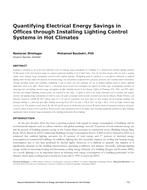Description
Lighting is considered as one of the most important issues in reducing energy consumption of a building. It is estimated that electrical lighting consumes25-40 percent of the total electrical energy in a typical commercial building in the United States. Over the last three decades, there has been a growingconcern about reducing energy consumption associated with artificial lightings. Daylighting could be considered as a cost-effective alternative to artificiallighting which not only reduces the demands for electrical energy, but also provides occupants with a pleasant, attractive, and a healthy indoor environment.Through installing sensors and controllers, daylighting is able to reduce and even eliminates the use of artificial lighting needed to deliver sufficientilluminance levels in an office. Present study is a simulation based research that investigates the impacts of various types of daylighting controllers onenhancing total and lighting electrical energy consumption of office buildings located in hot climates. Effects of Dimming (5%, 10%, and 20% light),On/Off, and Stepped Dimming control systems are evaluated in this study. E-Quest is used as the energy simulation tool to calculate and compareelectrical and lighting energy consumption. In order to assess the effects of daylight control systems in humid and arid hot climates, Miami, Phoenix, andHouston, located in ASHRAE 90.1 climate zones of 1, 2b, and 2a respectively, have been chosen as three locations for the prototype building. Theprototype building is a four-story open office building measuring 60 ft (18.3 m) wide x 120 ft (36.5 m) long x 48 ft (14.6 m) height oriented alongeast-west axis. The window to wall ratio of 20, 40, 60 and 90 percent in all directions are assessed. Windows consist of horizontal shading in all façadesas well as blinds in those of East and West. Results of this study demonstrate that in all studied cities installing daylighting controllers in office buildingssignificantly reduces electrical energy consumption of the building particularly that of lighting.
Citation: Second International Conference on Energy and Indoor Environment for Hot Climates, Doha, Qatar, February 2017
Product Details
- Published:
- 2017
- Number of Pages:
- 8
- Units of Measure:
- Dual
- File Size:
- 1 file , 990 KB
- Product Code(s):
- D-HCC17-22




